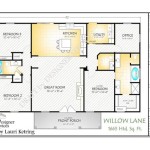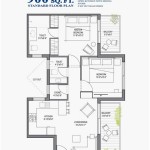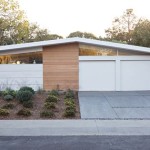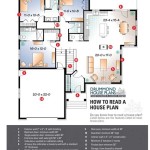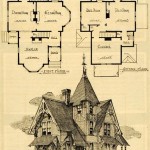A house plan with a separate in-law apartment is a residential design that incorporates a self-contained living space within a single-family home. It provides an independent and private living arrangement for elderly parents, adult children, or other extended family members while maintaining proximity to loved ones.
In-law apartments are often designed with their own kitchen, bathroom, bedroom, and living area, creating a comfortable and functional space for additional residents. This design allows for privacy and autonomy while facilitating interaction and support between family members. It can be an ideal solution for families seeking multi-generational living arrangements or providing care for aging loved ones.
Multiple factors should be considered when designing a house plan with a separate in-law apartment. These include the size and layout of the apartment, the level of independence desired by the occupants, and the overall aesthetic and functionality of the home. Additionally, it is essential to ensure the seamless integration of the in-law apartment into the main house, creating a harmonious and cohesive living space for all residents.
When considering a house plan with a separate in-law apartment, several key points merit attention:
- Independent living space
- Privacy and autonomy
- Functional and comfortable design
- Seamless integration
- Customizable layout
- Multi-generational living
- Aging-in-place support
- Caregiving convenience
- Enhanced property value
- Long-term investment
These factors can significantly impact the success and satisfaction derived from a house plan with a separate in-law apartment.
Independent living space
A separate in-law apartment provides an independent living space for extended family members, allowing them to maintain their privacy and autonomy while residing within the same household. This arrangement fosters a sense of independence and self-reliance, promoting the well-being and dignity of the occupants.
- Separate entrance
A dedicated entrance for the in-law apartment ensures privacy and minimizes disruption to both the main house and the apartment. It allows occupants to come and go as they please without disturbing others, maintaining their sense of independence.
- Private kitchen
A fully equipped kitchen within the in-law apartment provides occupants with the convenience and freedom to prepare their own meals and snacks. This promotes self-sufficiency and allows them to maintain their dietary preferences and routines.
- Private bathroom
A private bathroom is essential for maintaining privacy and dignity. It allows occupants to perform their daily routines in a comfortable and private setting, fostering a sense of independence and well-being.
- Separate living area
A designated living area within the in-law apartment provides a comfortable and private space for occupants to relax, entertain guests, or pursue their hobbies. This dedicated space promotes independence and allows occupants to maintain their own routines and activities.
An independent living space within a house plan with a separate in-law apartment empowers extended family members with privacy, autonomy, and self-reliance, contributing to their overall well-being and promoting harmonious multi-generational living.
Privacy and autonomy
Privacy and autonomy are fundamental aspects of a house plan with a separate in-law apartment. This design feature allows extended family members to maintain their independence and personal space while residing within the same household. Here’s a detailed explanation of how privacy and autonomy are ensured in such a living arrangement:
- Separate entrance
A dedicated entrance for the in-law apartment provides a physical and symbolic boundary between the main house and the apartment. It allows occupants to come and go as they please, without having to pass through the main living areas of the house. This separation enhances privacy and minimizes interruptions, fostering a sense of independence and self-reliance.
- Private kitchen
A fully equipped kitchen within the in-law apartment gives occupants the freedom to prepare their own meals and snacks at their convenience. This eliminates the need to share kitchen space with others, ensuring privacy and minimizing potential conflicts or interruptions. The ability to cook and dine independently promotes self-sufficiency and allows occupants to maintain their dietary preferences and routines.
- Private bathroom
A private bathroom is essential for maintaining privacy and dignity. It provides a dedicated space for occupants to perform their daily routines in a comfortable and private setting. The presence of a private bathroom within the in-law apartment eliminates the need to share bathroom facilities with others, reducing potential awkwardness or inconvenience. This feature contributes to the overall well-being and independence of the occupants.
- Separate living area
A designated living area within the in-law apartment provides a private and comfortable space for occupants to relax, entertain guests, or pursue their hobbies. This dedicated space allows them to maintain their own routines and activities without disturbing or being disturbed by others. The separate living area fosters a sense of independence and autonomy, empowering occupants to live their lives as they choose.
Overall, a house plan with a separate in-law apartment is thoughtfully designed to ensure the privacy and autonomy of its occupants. By providing separate entrances, private kitchens, bathrooms, and living areas, this design allows extended family members to maintain their independence and personal space while enjoying the benefits of multi-generational living.
Functional and comfortable design
The functional and comfortable design of a house plan with a separate in-law apartment is crucial for ensuring the well-being and satisfaction of its occupants. Here’s a detailed explanation of the key elements that contribute to the functionality and comfort of such a living arrangement:
- Accessible design
Accessibility is a vital consideration in the design of a separate in-law apartment. Features such as wide doorways, ramps, and grab bars can enhance accessibility and safety for occupants with limited mobility or physical impairments. Universal design principles ensure that the apartment is comfortable and accessible to all, regardless of age or ability.
- Ergonomic kitchen
The kitchen in the in-law apartment should be designed with ergonomics in mind, ensuring that it is both functional and comfortable to use. Well-placed appliances, ample counter space, and adjustable cabinetry can create an efficient and accessible workspace for meal preparation and cooking.
- Comfortable living area
The living area in the in-law apartment should be designed to provide a comfortable and inviting space for relaxation and socializing. Ample seating, natural lighting, and well-chosen furnishings can create a warm and welcoming atmosphere. This dedicated space allows occupants to unwind, entertain guests, or pursue their hobbies in a comfortable and private setting.
- Spacious bedroom
The bedroom in the in-law apartment should be designed to provide a restful and comfortable sleeping environment. Adequate space, a comfortable bed, and ample storage ensure a good night’s sleep and contribute to the overall well-being of the occupants.
By incorporating these elements into the design of a house plan with a separate in-law apartment, architects and homeowners can create a functional and comfortable living space that meets the needs and preferences of extended family members, promoting their independence, well-being, and overall quality of life.
Seamless integration
Seamless integration is a crucial aspect of a well-designed house plan with a separate in-law apartment. It ensures that the in-law apartment feels like a natural and harmonious part of the overall home while maintaining its. Here’s a detailed explanation of key points that contribute to seamless integration:
- Cohesive architectural style
The architectural style of the in-law apartment should complement the main house, creating a unified and aesthetically pleasing exterior. This can be achieved by using similar materials, colors, and design elements, ensuring that the apartment blends seamlessly into the overall structure.
- Shared outdoor space
Providing shared outdoor space, such as a patio or garden, can foster interaction and a sense of community between the occupants of the main house and the in-law apartment. This shared space can serve as a place for family gatherings, barbecues, or simply enjoying the outdoors.
- Interior connectivity
Thoughtful consideration should be given to how the in-law apartment connects to the main house. A well-designed layout can create seamless transitions between the two spaces, allowing for easy access and interaction while maintaining privacy. This can be achieved through well-placed doorways, hallways, and shared living areas.
- Shared amenities
Sharing certain amenities, such as a laundry room or home office, can enhance convenience and foster a sense of shared ownership. This strategic placement of shared spaces can minimize duplication and create a more efficient use of space within the overall home.
By incorporating these points into the design of a house plan with a separate in-law apartment, architects and homeowners can create a seamless and harmonious living environment that promotes interaction and a sense of unity while respecting the privacy and independence of its occupants.
Customizable layout
A customizable layout is a key feature of a well-designed house plan with a separate in-law apartment. It allows for flexibility and personalization to meet the specific needs and preferences of extended family members. Here’s a detailed explanation of the benefits and considerations related to customizable layouts:
- Adaptable to diverse needs
A customizable layout enables the in-law apartment to be tailored to the unique needs and preferences of its occupants. Whether it’s a single senior parent, a couple, or a small family, the layout can be disesuaikan to accommodate their specific requirements for space, accessibility, and functionality.
- Changing needs over time
As occupants age or their needs change, a customizable layout allows the in-law apartment to adapt and evolve accordingly. Modifications can be made to improve accessibility, enhance safety features, or reconfigure spaces to better suit the evolving needs of the occupants.
- Personalization and style
A customizable layout empowers occupants to personalize their living space and reflect their unique style. They can choose finishes, fixtures, and dcor that align with their preferences, creating a comfortable and inviting environment that feels like home.
- Future-proofing
A well-designed customizable layout can be future-proofed to accommodate potential changes in the family structure or the needs of the occupants. By incorporating flexible design elements and considering future expansion possibilities, the in-law apartment can be easily adapted to evolving circumstances.
When considering a house plan with a separate in-law apartment, it’s essential to work with an experienced architect or designer who can guide you through the customization process. By carefully planning the layout and incorporating adaptable design features, you can create a living space that meets the current and future needs of your extended family, fostering comfort, independence, and overall well-being.
Multi-generational living
Multi-generational living is a growing trend in today’s society, as families seek to live together and support one another. A house plan with a separate in-law apartment is an excellent option for families who want to enjoy the benefits of multi-generational living while maintaining their independence and privacy.
There are many benefits to multi-generational living. For older adults, it can provide companionship, emotional support, and assistance with daily tasks. For younger generations, it can offer opportunities to learn from and bond with their elders, as well as provide affordable housing options in expensive markets.
In addition to the social and emotional benefits, multi-generational living can also provide financial advantages. By sharing expenses such as housing, utilities, and childcare, families can save money and live more comfortably. Additionally, having multiple generations living together can allow for a more efficient use of space, as resources and amenities can be shared.
Overall, multi-generational living can be a rewarding and fulfilling experience for all involved. It offers a unique opportunity for families to connect, support one another, and create lasting memories.
Aging-in-place support
As we age, it becomes increasingly important to have a safe and supportive living environment that meets our changing needs. A house plan with a separate in-law apartment can provide an ideal solution for seniors who wish to age in place while maintaining their independence and dignity.
In-law apartments can be designed to incorporate a variety of aging-in-place features, such as wider doorways, ramps, and grab bars. These features can make it easier for seniors to move around safely and independently. Additionally, in-law apartments can be equipped with smart home technology, which can provide added convenience and peace of mind.
Another important consideration for aging-in-place is access to healthcare services. In-law apartments can be located near hospitals, clinics, and other healthcare providers. This can make it easier for seniors to receive the care they need without having to travel far from home.
Finally, it is important to consider the social and emotional needs of seniors. In-law apartments can provide a sense of community and belonging. Seniors can socialize with other residents, participate in activities, and receive support from family members who live nearby.
Overall, a house plan with a separate in-law apartment can provide an ideal solution for seniors who wish to age in place. By incorporating aging-in-place features, providing access to healthcare services, and fostering a sense of community, in-law apartments can help seniors live safely, independently, and with dignity.
Caregiving convenience
A house plan with a separate in-law apartment can also offer significant convenience for caregivers. Here are a few key caregiver convenience features of this type of home design:
- Proximity to loved ones
With an in-law apartment, caregivers can live in close proximity to their loved ones without having to share the same living space. This can make it easier to provide assistance with daily tasks, such as cooking, cleaning, and bathing, while still allowing for independence and privacy.
- Private caregiving space
In-law apartments typically have their own private entrance, living area, and bathroom. This provides caregivers with a dedicated space to provide care without disturbing the main household. It also allows them to store medical equipment and supplies without cluttering up the main living areas.
- 24/7 access
Unlike traditional nursing homes or assisted living facilities, in-law apartments allow caregivers to be present 24/7. This can provide peace of mind and reassurance, knowing that their loved one is never alone and can receive assistance whenever needed.
- Reduced stress and burnout
Caregiving can be a demanding and stressful task. Having a separate in-law apartment can help to reduce stress and burnout for caregivers. By providing a private and convenient space to provide care, caregivers can better manage their own time and well-being.
Overall, a house plan with a separate in-law apartment can offer significant convenience and support for caregivers. By providing proximity to loved ones, a private caregiving space, 24/7 access, and reduced stress, this type of home design can help caregivers provide the best possible care for their loved ones while maintaining their own well-being.
Enhanced property value
Adding a separate in-law apartment to a house plan can significantly enhance its property value. Here are a few key reasons why:
- Increased square footage
In-law apartments typically add additional square footage to a home, which can increase its overall value. This additional space can be used for a variety of purposes, such as accommodating extended family members, renting out for additional income, or simply providing more living space for the main household.
- Multi-generational appeal
In-law apartments are becoming increasingly popular among multi-generational families. By providing a separate living space for elderly parents or adult children, homeowners can create a more comfortable and convenient living arrangement for all family members. This multi-generational appeal can make a home more attractive to potential buyers, especially those with extended families.
- Aging-in-place potential
As the population ages, there is a growing demand for homes that can accommodate aging-in-place. In-law apartments can be designed to include features that make them suitable for seniors, such as wider doorways, ramps, and grab bars. This can make a home more appealing to older buyers who are looking for a place where they can live independently and safely.
- Rental income potential
In-law apartments can also be rented out to generate additional income. This can be a great way to offset the cost of owning a home or to supplement retirement savings. In some areas, in-law apartments can be rented out for a significant amount of money, making them a valuable asset.
Overall, adding a separate in-law apartment to a house plan can significantly enhance its property value. By increasing square footage, appealing to multi-generational families, providing aging-in-place potential, and offering rental income potential, in-law apartments can make a home more attractive to a wider range of buyers and increase its overall worth.
Long-term investment
Investing in a house plan with a separate in-law apartment can be a wise long-term investment for several reasons:
- Appreciation potential
Real estate values tend to appreciate over time, and homes with in-law apartments are no exception. The additional square footage and multi-generational appeal of these homes can make them more desirable to buyers, leading to higher resale values in the long run.
- Rental income potential
As mentioned earlier, in-law apartments can be rented out to generate additional income. This rental income can help to offset the cost of owning a home, supplement retirement savings, or simply provide a passive income stream. Over time, the rental income generated from an in-law apartment can add up to a significant financial return.
- Aging-in-place value
As the population ages, the demand for homes that can accommodate aging-in-place is increasing. In-law apartments can be designed to include features that make them suitable for seniors, such as wider doorways, ramps, and grab bars. This can make a home more valuable to older buyers who are looking for a place where they can live independently and safely. In the long run, this can translate into a higher resale value for the home.
- Tax benefits
In some cases, homeowners may be eligible for tax benefits when they have a separate in-law apartment. For example, some states offer property tax exemptions for homes that are used to care for elderly or disabled family members. Additionally, homeowners may be able to deduct certain expenses related to the in-law apartment, such as mortgage interest and property taxes.
Overall, investing in a house plan with a separate in-law apartment can be a sound long-term investment. The potential for appreciation, rental income, aging-in-place value, and tax benefits can make this type of home a valuable asset over time.










Related Posts

